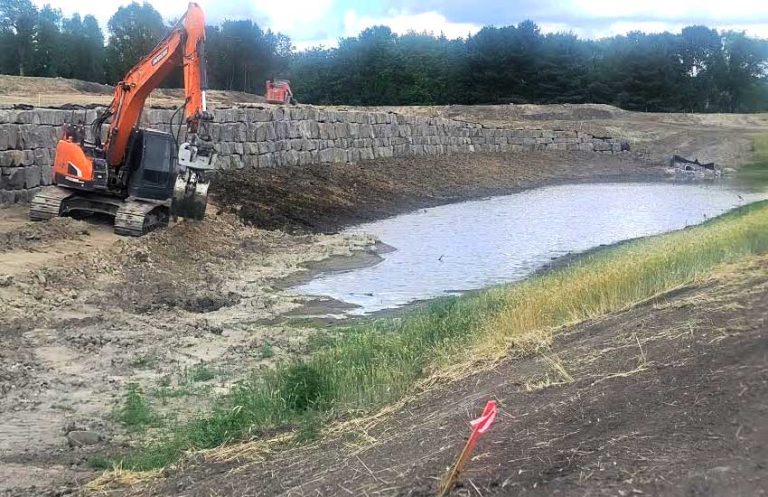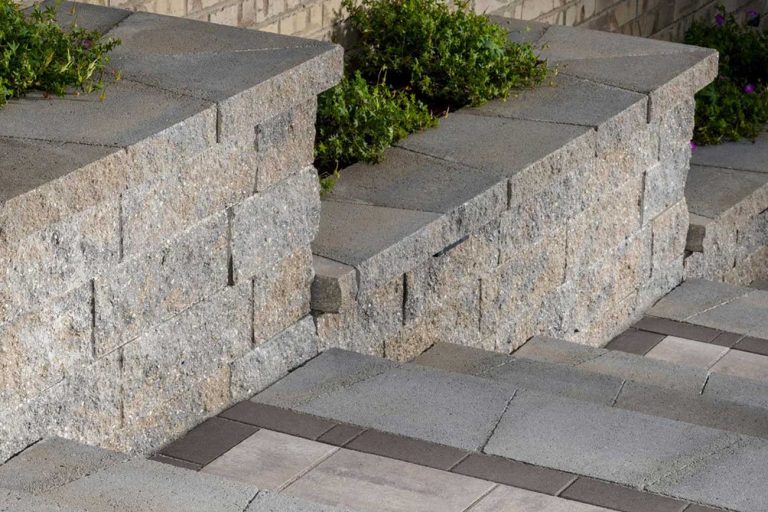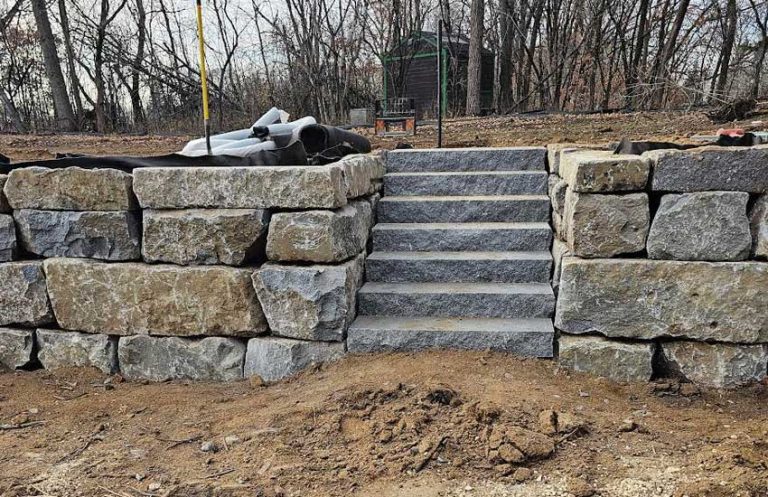Retaining Wall Landscaping
You’re considering a retaining wall for your landscaping needs. It’s more than just stacking bricks. A well-designed wall can prevent soil erosion, manage water runoff, and provide a notable charm to your outdoor space. But, how do you select the right materials? And what goes into maintaining its longevity? There’s a lot to unpack here, let’s start the discussion.
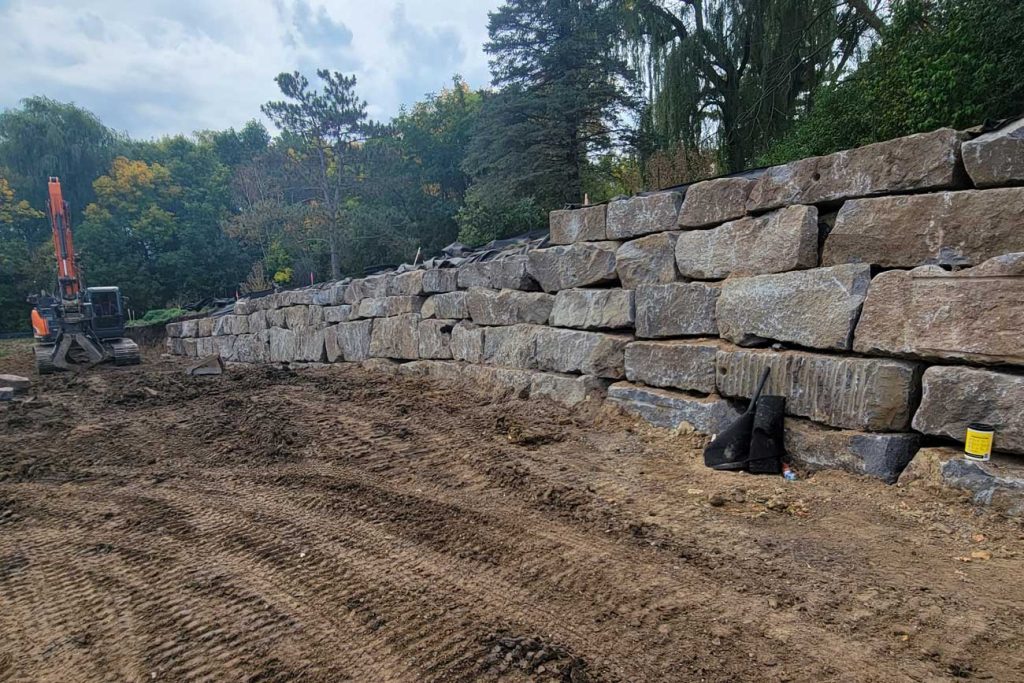
Understanding Retaining Wall Landscaping
Let’s explore the concept of retaining wall landscaping, an essential aspect of enhancing the aesthetics and functionality of your outdoor space. You see, retaining walls aren’t just about holding soil in place; they’re also about adding an extra layer of beauty to your yard.
Think of them as canvases where you can express your creativity. You can incorporate plants, lighting, and even water features into your retaining wall design. Climbing plants, for instance, give a natural, rustic feel, while lighting can create a dramatic effect when the sun goes down.
Remember, it’s also about functionality. Retaining walls can help manage water runoff, prevent soil erosion, and create usable space on sloped land. They can even provide seating if they’re built at the right height.
When planning your retaining wall landscaping, consider the overall design of your yard. Make sure it complements your existing landscape, rather than clashing with it.
Lastly, don’t forget about maintenance. Some features may require more upkeep than others, so choose something that fits your lifestyle and schedule. With careful planning and design, retaining walls can be a valuable addition to your outdoor space.
Essential Materials for Retaining Walls
Before you start constructing your retaining wall, it’s crucial to contemplate the materials you’ll use. The quality of your materials can greatly affect the longevity and durability of your wall. Additionally, sustainable material options exist that can help lessen your environmental impact.
Choosing Quality Materials
When it comes to building a solid and aesthetically pleasing retaining wall, selecting high-quality materials is an essential step you can’t overlook. The right materials add longevity, durability, and style to your wall. They’ll guarantee it can withstand the pressures of time and weather, and will look great doing it.
Quality is key, but how do you decide what’s quality? Here are three considerations:
- Durability: The best materials don’t degrade easily. They’ll hold up under pressure, and won’t crumble when it matters most. Your wall needs to last, and durability is a must-have.
- Visual Appeal: Your wall isn’t just functional, it’s a part of your landscape. The right materials will enhance your yard’s aesthetic, not detract from it. Choose materials that blend beautifully with your surroundings.
- Ease of Installation: High-quality doesn’t mean complicated. Select materials that are straightforward to install. You’ll save time, avoid frustration, and get a better result.
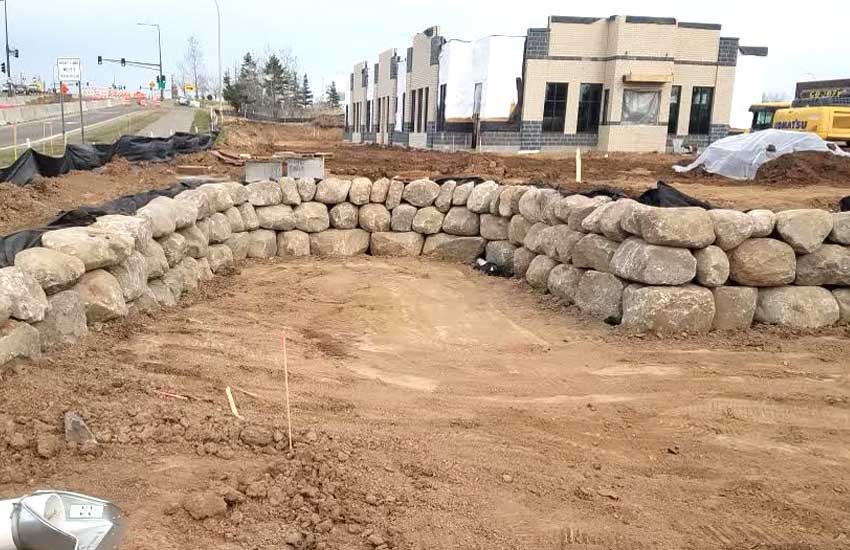
Sustainable Material Options
When selecting sustainable materials for your retaining wall, you must consider options that are not only durable and visually appealing, but also environmentally friendly. Keep in mind that using sustainable materials doesn’t mean sacrificing quality or aesthetics.
Consider recycled concrete or reclaimed stone. These materials are as sturdy as their new counterparts, but their use helps reduce waste and curb the environmental impact of manufacturing new materials. You’re not just creating a visually appealing retaining wall, but also contributing positively to the environment.
Another option is rammed earth. It’s not only sturdy and long-lasting, but also completely natural. It’s literally the earth under your feet, compacted into a firm, solid wall. It blends seamlessly with any landscape and adds an organic touch to your garden.
Timber, though a traditional material, can be a green choice if sourced responsibly. Look for locally-sourced, FSC-certified wood to make sure that you’re not contributing to deforestation.
Steps to Build a Retaining Wall
Now that we’ve discussed the materials needed, let’s move on to the essential steps for building your retaining wall. First, we’ll explore how to choose the right materials for your specific needs. Then, we’ll guide you through the construction process and discuss how to maintain your wall to guarantee longevity.
Choosing Suitable Materials
You’ll need to pick out sturdy, durable materials that can stand up to the elements when building your retaining wall. The right materials will not only guarantee the longevity of your wall, but also enhance the aesthetic appeal of your landscape.
Choosing suitable materials can be a challenging task, especially if you’re new to this. But don’t worry, you’re not alone. We’re all part of a community committed to creating beautiful, lasting landscapes.
Consider the following materials:
- Concrete Blocks: They’re strong and easy to work with. Plus, their modular nature allows for various design possibilities.
- Natural Stone: If you’re after a classic, timeless look, natural stone is your best bet. It’s resilient and comes in a variety of colors and textures.
- Timber: While not as durable as stone or concrete, timber can provide a warm, rustic appeal to your landscape.
Construction and Maintenance
Often, the first step in building your retaining wall is preparing the base. You’ll need to dig a trench that’s wide and deep enough to accommodate the first layer of blocks. Make sure it’s level; an uneven base can lead to a shaky wall.
Next, lay a bed of gravel in the trench. This provides drainage and helps keep the wall stable. Pack it down firmly before starting to lay your blocks. Remember, each block needs to be level both with the block next to it and the one behind it.
Now, you’re ready to start building up. Stack the blocks, ensuring they’re secure and level. Backfilling with gravel as you go helps with drainage and stability. Don’t rush this process; it’s important to get it right.
Once the wall is up, cap it off with a final layer of blocks or a concrete cap. This gives a finished look and adds extra strength.
For maintenance, regularly check your wall for signs of movement or damage. Promptly fix any issues to prevent larger problems down the line. It’s easier to replace a few blocks than to rebuild the whole wall.
Building a retaining wall is a big project, but with careful planning and regular maintenance, it’s something you can achieve.
Retaining Wall Aesthetics and Design Ideas
Exploring various aesthetics and design ideas can greatly enhance the appeal of your retaining wall. While it’s important to make sure that your wall is sturdy and functional, it’s equally vital to make it visually pleasing. This isn’t just about vanity, it’s about creating a space where you feel comfortable, proud, and at home.
Here are three design ideas that can help you achieve this:
- Natural stone wall: Embrace the beauty of nature by using natural stones. They add a rustic, timeless appeal that blends seamlessly with your outdoor space. You’ll feel connected to the landscape and enjoy a sense of tranquility.
- Mosaic design: If you’re after a more artistic look, consider a mosaic design. It’s a chance to express your creativity and add a pop of color. You’ll create a unique, personal touch that sparks joy every time you look at it.
- Terraced garden: A terraced garden is not only practical but also visually striking. It brings a sense of order and sophistication, creating a serene, well-structured space that you can be proud of.
Handling Erosion With Retaining Walls
When it comes to erosion control, retaining walls play an essential role in safeguarding your landscape. They’re not just for looks; they help hold back soil and prevent it from washing away. This is especially important if you’re dealing with a steep slope or loose soil.
Now, you might be asking, ‘how does a retaining wall prevent erosion?’ It’s pretty simple. The wall acts as a barrier, stopping the soil from moving downhill. When it rains, instead of the water carrying the soil away, it hits the wall and drains down, keeping your soil in place.
But it’s not enough to just have any wall. It’s vital to choose the right materials and design for your retaining wall to effectively combat erosion. Stone, concrete, and timber are popular choices due to their durability and strength. The wall needs to be sturdy enough to withstand the pressure of the soil and water it’s holding back.
It’s also important to take into account the height of the wall. Too high, and it may not be able to support the weight of the soil; too low, and it won’t provide enough protection. So, it’s all about finding that perfect balance.
Retaining Walls for Sloped Gardens
If you’re dealing with a sloped garden, a strategically designed retaining wall can turn that challenging landscape into a unique garden feature. Not only does it provide a level area for planting, it also adds aesthetic appeal and charm to your green space.
- Creativity: A sloped garden provides an opportunity for you to express your creativity. A terraced retaining wall, for example, can transform your garden into an artistic landscape with multiple levels of beauty.
- Functionality: A retaining wall improves the usability of your garden. No more struggling with uneven terrain. You can now plant with ease and enjoy your garden without any limitations.
- Community: With a leveled garden, you can host outdoor gatherings, creating a space where your loved ones can connect and feel a sense of belonging.
Maintenance Tips for Retaining Walls
Now that you’ve installed a retaining wall in your sloped garden, it’s important to know how to maintain it properly to guarantee its longevity and functionality. Here are some handy maintenance tips to help you keep your wall in top shape.
First, regularly inspect your wall for any signs of damage. Cracks, bulges, and tilting could indicate structural issues. Promptly address these problems to prevent further deterioration. Second, make sure good drainage. Water accumulation can weaken the wall and cause it to collapse. So, clear out any debris blocking your wall’s drainage system.
Third, don’t forget to prune the vegetation around your wall. Overgrown roots can cause damage. Trim these back periodically. Finally, clean your wall. A simple hose down can remove dirt and prevent stains, keeping your wall looking its best.
Cost Analysis of Retaining Wall Landscaping
Diving into the financial aspect, let’s examine the costs associated with landscaping a retaining wall. You might be wondering, “how much is this going to set me back?” Well, that depends on several factors.
- Material: The material of your retaining wall is the main cost driver. Natural stone, for instance, is more expensive than concrete blocks or timber.
- Size and Design: The larger and more complex the design, the higher the cost. A simple, small wall is more affordable than a large, intricate design.
- Professional Services: If you’re hiring professionals, you’ll need to account for their labor costs. Doing it yourself can save money, but it may be more time-consuming and challenging.


